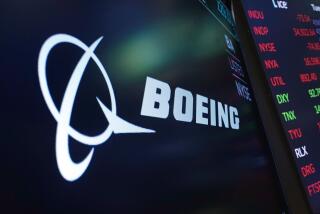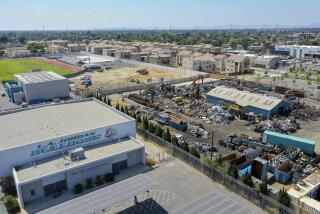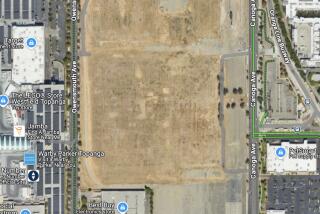Workers See Safety Report as Ammunition in Suit Against Lockheed : The OSHA Citations
- Share via
Mark Gillaspie, a 29-year-old La Crescenta man, is one of 88 current and former Lockheed Corp. workers who are suing the big aerospace company, alleging that their exposure to harmful chemicals at Lockheed’s Burbank manufacturing plant made them seriously ill.
Gillaspie, who went on medical leave last fall complaining of rashes, headaches, memory loss and other maladies, has yet to have his day in court. The workers’ eight lawsuits, the first of which was filed more than two years ago in state Superior Court in Burbank, are still pending and no trial dates have been set.
Yet Gillaspie said last week that he and his fellow workers already are victorious--thanks to the federal government.
“I myself feel that our case has been won,” Gillaspie said. “Whether it was a mistake or not, the fact still remains we were exposed to dangerous chemicals and OSHA has proved it.”
OSHA is the U.S. Occupational Safety and Health Administration, which last week cited the Lockheed plant for 440 alleged safety violations and proposed $1.5 million in fines. The citations followed a four-month investigation of some sections of the plant that began last September.
The sprawling plant is where Lockheed is building, among other things, a top-secret stealth fighter. Stealth aircraft typically are made with plastic-like composites, materials made of chemicals and fibers that are lightweight, strong and absorb radar signals, making the planes harder to detect than metal-bodied jets.
Lockheed, which is reviewing OSHA’s report, can contest all or some of the citations before a review commission. The company also is defending itself against the lawsuits, some of which allege that Lockheed was negligent and intentionally concealed the fact that workers were being exposed to dangerous chemicals.
If many of OSHA’s allegations are upheld, the question becomes: What effect will OSHA’s report have on the workers’ pending lawsuits?
That answer could be: Plenty. If the workers can first establish in court that Lockheed fraudulently concealed the chemicals’ danger from the workers, as the workers are trying to do, “then they can bring the OSHA results in to buttress their case that there were indeed unsafe working conditions,” said Merle Rabine, head of the California Applicants Attorneys Assn., a group of lawyers who represent employees in workers compensation cases.
Rabine, who is not involved in the Lockheed case, said the fraudulent concealment aspect is important because it is a test that often must be met for an employee-versus-employer lawsuit to go forward.
In theory, workers compensation systems are supposed to prevent such suits. Workers compensation is meant to be the exclusive remedy for employees seeking reimbursement for illness or injury caused in the work place. And in California, workers compensation is a no-fault system, which means a worker’s claim depends on whether the injury or sickness was caused at work--regardless of who was at fault.
But if an employee can establish that the employer fraudulently concealed the cause of the injury, or engaged in “serious and willful misconduct” that led to the injury, then an employee’s suit can proceed, Rabine said.
Timothy A. Larson, an Encino lawyer who is representing many of the Lockheed workers in their lawsuit, said the courts will see the OSHA report “as further corroboration and verification of what our clients had indicated regarding their health.”
Lockheed spokesman James Ragsdale acknowledged that “it seems possible” that OSHA’s report could find its way into the courtroom. “But Lockheed is not in a position to speculate about what effect any OSHA findings may have on any of the litigation that’s now pending,” he said.
About 150 workers compensation claims also have been filed against Lockheed by workers at the Burbank plant, also on grounds they were harmed at the facility.
Lockheed’s Burbank plant is actually 200 buildings spread around the city with about 14,000 employees, and some of its biggest facilities are located just east of the Burbank Airport. Some of the buildings can be toured by the public. Lockheed recently showed a visitor its Composite Development Center, where Lockheed experiments with composite materials to see how they can be used on aircraft.
Workers at the center heat, pressurize and tailor composites to make full-scale models of airplane wings, doors and cockpits. For example, instead of using thick steel riveted together to make a wing surface, Lockheed is experimenting with wing surfaces made of hardened composites that sandwich a lightweight honeycomb material. The lighter materials reduce the plane’s weight, making it more versatile and fuel-efficient.
But other Lockheed buildings are top secret, and workers there are prohibited from discussing any classified projects. Even in their lawsuits, the workers did not spell out what their jobs entailed if they worked in secret areas.
Specific Buildings
One of the lawsuits listed all the chemicals that allegedly caused the workers’ illnesses as being found in Lockheed’s Building 351. Many of the alleged violations cited by OSHA also were located in Building 351 and Building 199.
Lockheed’s Ragsdale would say only that both buildings are used in manufacturing, and that other information is not disclosed because the buildings are involved “in classified Department of Defense projects.”
But Gillaspie and other workers suing Lockheed said that in the mid-1980s, some of the buildings were extremely dangerous. There, employees worked with poisonous chemicals and other substances without protective clothing, proper warnings on how to use the materials and adequate ventilation, they alleged.
“Pure silver and pure copper were being sprayed out of paint guns,” Gillaspie said. “Nobody thought a damn thing about it, including me.”
OSHA’s 461-page report found dozens of instances in which Lockheed allegedly failed to correctly label drums of hazardous chemicals on the site, failed to ensure that workers wore gloves and had other adequate protection from the substances, and failed to record illnesses and injuries that occurred at the plant.
Markings Cited
OSHA also allegedly found several containers of chemicals that were unmarked or poorly labeled. In one instance, OSHA said, there were three 30-gallon drums and one 55-gallon drum in Building 199 that contained a surface coating mix of various dangerous chemicals, but were labeled only as “skybond mix” and without appropriate hazard warnings, OSHA said.
The “very nature and sheer volume” of the alleged safety violations has prompted OSHA to send its inspectors back for a “wall-to-wall” inspection of the entire Burbank plant.
Not all the workers involved in the lawsuits shared Gillaspie’s view that OSHA has, in effect, verified their claims.
“I don’t know if it will affect the lawsuit or not,” said Shirley Haws, a Sun Valley resident who quit Lockheed in June, 1986, after working at the plant since 1979. Haws, who claims to have suffered stomach and sinus problems, anxiety and memory loss from working at the plant, asserted that plant conditions were much worse a few years ago.
“I’m sure by the time OSHA got there, there had been a great many changes,” she said.
Other workers expressed surprise that OSHA still found hundreds of alleged violations more than two years after the workers’ lawsuits asserted there were problems at the site.
Aware of Inspection
Lockheed “knew OSHA was coming in, had a good length of time to prepare, and they screwed up royally,” said Clyde Glasser of Burbank, who retired in 1985 after more than 30 years with Lockheed, and who is also a plaintiff in the lawsuits. “Just think what would have happened if they would have looked in 1985.”
Gillaspie criticized OSHA for not immediately responding to the workers’ lawsuits, and says the agency only stepped in after Gillaspie appeared on ABC News’ “Nightline” television program Sept. 22 to comment on the Lockheed case.
“They were embarrassed on national television,” Gillaspie said. “They were exposed for not doing their job.”
Frank Gravitt, head of OSHA’s Los Angeles office, led the inspection of Lockheed. He noted that until July, 1987, responsibility for enforcing job safety and health laws in California’s private sector was handled by state officials. At that point, federal OSHA officials took over, but it was not until August, 1988, that complaints about Lockheed’s site began coming into OSHA, Gravitt said.
More to Read
Inside the business of entertainment
The Wide Shot brings you news, analysis and insights on everything from streaming wars to production — and what it all means for the future.
You may occasionally receive promotional content from the Los Angeles Times.











